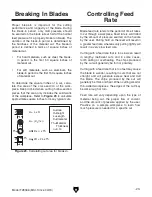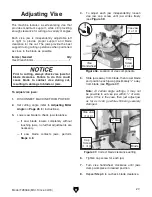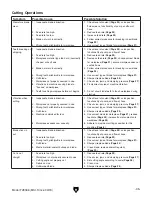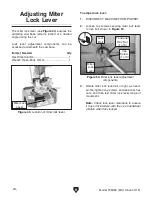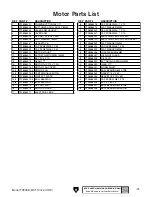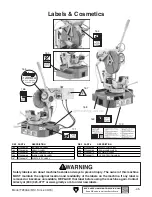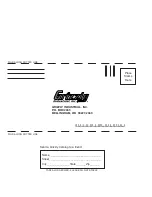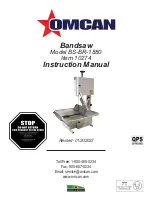
Model T28366 (Mfd. Since 04/18)
-35-
Symptom
Possible Cause
Possible Solution
Premature blade
wear.
1. Inadequate blade lubrication.
2. Feed rate too high.
3. Feed rate too low.
4. Blade not worn in correctly.
5. Wrong tooth pitch/profile for workpiece.
1. Check level of coolant (
Page 30), valve position,
fluid screens, functionality of pump, and flow of
hose.
2. Reduce feed rate (
Page 23).
3. Increase feed rate (
Page 23).
4. Follow correct procedure for breaking in new blade
(
Page 23).
5. Use correct type of blade for workpiece (
Page 21).
Teeth breaking or
chipping.
1. Inadequate blade lubrication.
2. Feed rate too high.
3. Workpiece material type too hard, incorrectly
shaped, or has flaws.
4. Blade not worn in correctly.
5. Wrong tooth pitch/profile for workpiece.
6. Dull blade.
7. Workpiece not properly secured in vise.
8. Vibrations in machine causing blade to
"bounce" on workpiece.
9. Teeth touching workpiece before cut begins.
1. Check level of coolant (
Page 30), valve position,
functionality of pump, and flow of hose.
2. Reduce feed rate (
Page 23).
3. Decrease feed rate (
Page 23), choose correct blade
for workpiece (
Page 21); ensure workpiece does not
contain flaws.
4. Follow correct procedure for breaking in new blade
(
Page 23).
5. Use correct type of blade for workpiece (
Page 21).
6. Sharpen/replace blade (
Page 24).
7. Check vice, jaws, and clamping pressure (
Page 27).
8. Find/correct source of machine vibration.
9. Do not allow blade teeth to touch workpiece during
start-up.
Vibration when
cutting.
1. Inadequate blade lubrication.
2. Workpiece not properly secured in vise.
3. Wrong tooth pitch/profile for workpiece.
4. Dull blade.
5. Machine undersized for task.
6. Workpiece exceeds saw capacity.
1. Check level of coolant (
Page 30), valve position,
functionality of pump, and flow of hose.
2. Check vice, jaws, and clamping pressure (
Page 27).
3. Use correct type of blade for workpiece (
Page 21).
4. Sharpen/replace blade (
Page 24).
5. Use correct blade for workpiece (
Page 21); reduce
feed rate (
Page 23); increase flow of coolant onto
workpiece (
Page 20).
6. Adhere to maximum cutting capacities for this
machine (
Page 6).
Blade sticks in
cut.
1. Inadequate blade lubrication.
2. Feed rate too high.
3. Wrong tooth pitch/profile for workpiece.
4. Dull blade.
5. Waste material/coolant buildup on blade.
1. Check level of coolant (
Page 30), valve position,
functionality of pump, and flow of hose.
2. Reduce feed rate (
Page 23).
3. Use correct type of blade for workpiece (
Page 21).
4. Sharpen/replace blade (
Page 24).
5. Clean blade, replace coolant regularly
(
Page 30).
Cut is not
straight.
1. Feed rate too high.
2. Workpiece is not properly secured in vise.
3. Cutting angle not properly set.
4. Debris on vise.
5. Dull/warped blade.
1. Reduce feed rate (
Page 23).
2. Check vice, jaws, and clamping pressure (
Page 27).
3. Set cutting angle according to scale (
Page 28).
4. Clean vise.
5. Sharpen/replace blade (
Page 24).
Cutting Operations



